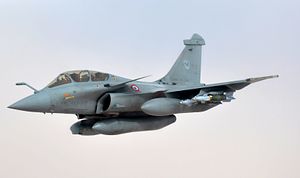With Indian Prime Minister Narendra Modi’s big announcement in Paris that New Delhi would purchase 36 Dassault Rafale multi-role fighters off-the-shelf (prêt-à-porter, if you will) in a government-to-government deal, the future of the $20 billion tender for India’s medium multi-role combat aircraft (MMRCA) that was being negotiated between France’s Dassault Aviation and the Indian government fell into limbo. That ambiguity was resolved on Monday, three days after Modi’s announcement, when Indian Defense Minister Manohar Parrikar clarified that the $20 billion tender would not move forward. Just like that, the “mother of all defense deals,” as India’s MMRCA project was known, was dead.
Though Parrikar avoided shutting the door on the project entirely, he emphasized that the Indian government would not move forward with those negotiations for the moment, suggesting that if New Delhi does purchase additional Rafales, it will do so in another government-to-government deal. His ministry’s official spokesperson, Sitanshu Kar, tweeted that the “[government-to-government] route [is] better than the [request for proposal] path for acquisition of strategic platforms.” Parrikar additionally said that the government’s decision to go with a direct purchase of 36 Rafale fighters was necessary, likening the deal to a breath of “oxygen” for India’s constrained air force.
Parrikar’s announcement is being read with a degree of trepidation in India’s strategic community. The government’s pragmatic decision to fulfill the Indian Air Force’s short-term need for a multi-role fighter is commendable, but, concurrently, the decision to scrap Dassault’s tender for the broader MMRCA contract is a set back for the Modi government’s bid to indigenize India’s defense production. With the deal announced in Paris, France yields nothing in the way of technology transfer.
As recently as February 2015, reports suggested that a final deal would see India’s Hindustan Aeronautics Limited (HAL) build 108 of the envisaged 126 total Rafale jets (with the remaining 18 coming form France). In late 2014, Parrikar met his French counterpart and the two pledged to put negotiations on a “fast track.” France ultimately refused to budge, given Dassault’s concerns about HAL’s ability to construct the Rafale fighters up to spec and liability issues. In the meantime, the IAF needed to see some light at the end of the tunnel and pressure continued to build on the government to deliver some deal. All of this culminated in the recently announced government-to-government agreement in Paris.
Ajai Shukla, a defense commentator for India’s Business Standard wrote after Parrikar’s announcement, that with India’s decision to purchase 36 Rafales in ready-to-fly condition, “the French were rewarded for their obstinacy with exactly what they wanted – an order for fully built aircraft without the need to transfer technology.” For France, the Rafale had turned into somewhat of a marketing nightmare, with prospective buyers bowing out over concerns about the high cost-per-unit and maintenance costs of the Rafale. Thus, concluding a deal with India will be a major breath of relief for the French. Better yet, with no intellectual property transfer, Dassault can expect to cash future Indian checks for the maintenance and upgrades for the Rafale fighters.
If negotiations had persisted, New Delhi would have been able to tout a major win when it came to its ability to indigenously manufacture advanced defense technology, despite the design being of foreign origin. Even if, hypothetically, New Delhi managed to construct a fraction of the 108 Rafale fighters on Indian soil, the deal would have been a major step forward for India’s domestic defense industry. Instead, the procurement process for the Rafale fighters has come to resemble India’s tried-and-tested approach of purchasing ready-built equipment from foreign suppliers.
Finally, Parrikar’s announcement likely means that India’s total Rafale fleet will likely never come close to reaching 126 fighters. Without domestic production, India will be hard pressed to justify future procurement beyond an additional squadron or two. To preemptively stave off critics, Parrikar noted that “all options are being kept open,” including on the issue of building Rafales in India, but with the precedent set in Paris last week, getting to that point will be more of an uphill struggle than ever.
































